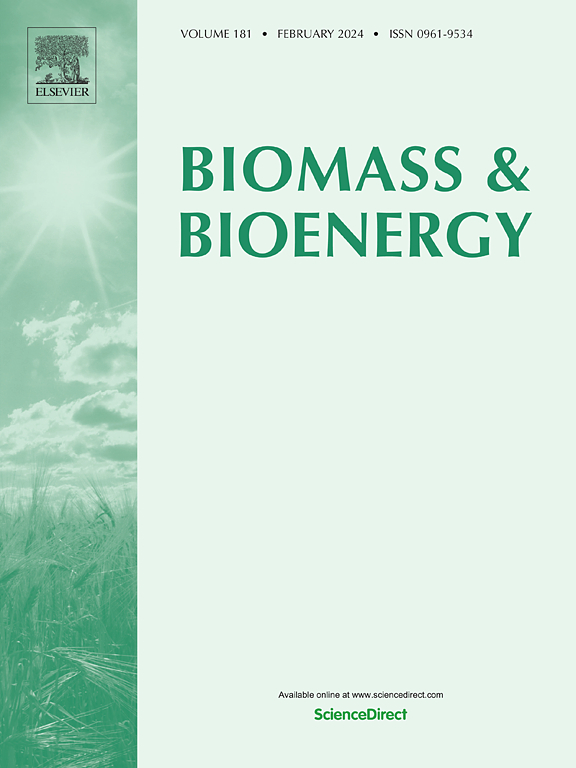Effect of torrefaction severity on the energy recovery from amazonian wood residues for decentralized energy conversion systems
IF 5.8
2区 生物学
Q1 AGRICULTURAL ENGINEERING
引用次数: 0
Abstract
Brazil features over 196 isolated energy systems, mainly in the Amazonia, relying on diesel-fired conversion for about 96 % of their energy supply. Given diesel's cost and pollution, there's a significant potential for waste wood from sustainable forest management. This study originally assessed torrefaction (225–275 °C, 60 min) to enhance the energy density of a blend (AB) consisting of six (16.66 %) waste wood: Peltogyne lecointei, Erisma uncinatum, Martiodendron elatum, Handroanthus incanus, Dipteryx odorata, and Allantoma decandra. Torrefaction was evaluated through severity indexes, morphological modification, analytical (proximate, ultimate, and calorific) characterizations and kinetic modeling. TGA assessed the torrefied blend's combustion behavior, and related emissions were determined numerically. Torrefaction modifies the raw material by significantly reducing H/C (from 1.87 to 1.05) and O/C (from 0.70 to 0.47) ratios. Considering AB275, fixed carbon sees a 159 % increase, and volatile matter (VM) decreases by 68.3 %. The low ash (0.63 %) in the final product indicates the potential for direct burning and blending for low-ash biofuel. The higher heating value improved from 20.22 to 21.64 MJ kg−1 (1.07 energy densification). Morphological analysis indicated increasing particulate matter and enhanced porosity. The two-step kinetic modeling precisely predicted the solid yield, with R2 values of 0.9979, 0.9951, and 0.9996 for AB225, AB250, and AB275. Torrefaction improved thermal stability, impacting ignition dynamics due to lower O/C and VM. Emission factors from the combustion of torrefied products reported lower emissions than diesel, coal and other biomasses: CO2, NOx, and SO2 at 1281.67–1487.48, 1.12–1.72, and 0.16–0.25 kg ton−1, respectively.

干燥程度对分散能量转换系统中亚马逊木渣能量回收的影响
巴西拥有超过196个独立的能源系统,主要在亚马逊地区,依靠柴油转换提供约96%的能源供应。考虑到柴油的成本和污染,可持续森林管理的废木材有很大的潜力。本研究最初评估了加热(225-275°C, 60分钟)以提高由六种(16.66%)废木材组成的混合物(AB)的能量密度:Peltogyne lecointei, Erisma uncinatum, Martiodendron elatum, Handroanthus incanus, Dipteryx odorata和Allantoma decandra。通过严重程度指数、形态修饰、分析(近似、最终和热量)表征和动力学建模来评估烘烤。TGA评估了碳化混合物的燃烧性能,并对相关排放进行了数值计算。焙烧通过显著降低H/C(从1.87降至1.05)和O/C(从0.70降至0.47)比率来改性原料。考虑AB275,固定碳增加159%,挥发性物质(VM)减少68.3%。最终产品的低灰分(0.63%)表明直接燃烧和混合低灰分生物燃料的潜力。高热值由20.22 MJ kg−1提高到21.64 MJ kg−1(能量密度1.07)。形态分析表明颗粒物质增加,孔隙度增大。AB225、AB250和AB275的R2分别为0.9979、0.9951和0.9996。焙烧提高了热稳定性,降低了O/C和VM,从而影响了点火动力学。碳化产品燃烧产生的排放因子比柴油、煤和其他生物质低:二氧化碳、氮氧化物和二氧化硫的排放量分别为1281.67-1487.48、1.12-1.72和0.16-0.25 kg t - 1。
本文章由计算机程序翻译,如有差异,请以英文原文为准。
求助全文
约1分钟内获得全文
求助全文
来源期刊

Biomass & Bioenergy
工程技术-能源与燃料
CiteScore
11.50
自引率
3.30%
发文量
258
审稿时长
60 days
期刊介绍:
Biomass & Bioenergy is an international journal publishing original research papers and short communications, review articles and case studies on biological resources, chemical and biological processes, and biomass products for new renewable sources of energy and materials.
The scope of the journal extends to the environmental, management and economic aspects of biomass and bioenergy.
Key areas covered by the journal:
• Biomass: sources, energy crop production processes, genetic improvements, composition. Please note that research on these biomass subjects must be linked directly to bioenergy generation.
• Biological Residues: residues/rests from agricultural production, forestry and plantations (palm, sugar etc), processing industries, and municipal sources (MSW). Papers on the use of biomass residues through innovative processes/technological novelty and/or consideration of feedstock/system sustainability (or unsustainability) are welcomed. However waste treatment processes and pollution control or mitigation which are only tangentially related to bioenergy are not in the scope of the journal, as they are more suited to publications in the environmental arena. Papers that describe conventional waste streams (ie well described in existing literature) that do not empirically address ''new'' added value from the process are not suitable for submission to the journal.
• Bioenergy Processes: fermentations, thermochemical conversions, liquid and gaseous fuels, and petrochemical substitutes
• Bioenergy Utilization: direct combustion, gasification, electricity production, chemical processes, and by-product remediation
• Biomass and the Environment: carbon cycle, the net energy efficiency of bioenergy systems, assessment of sustainability, and biodiversity issues.
 求助内容:
求助内容: 应助结果提醒方式:
应助结果提醒方式:


